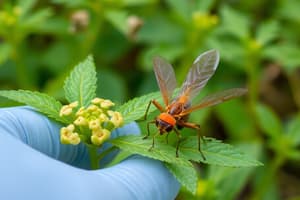Podcast
Questions and Answers
What is the primary goal of an Integrated Pest Management program?
What is the primary goal of an Integrated Pest Management program?
- To reduce the cost of pest control measures
- To increase the use of cultural and sanitation practices
- To eliminate pests completely through the use of pesticides
- To achieve long-term, environmentally sound pest suppression (correct)
Which of the following is NOT a key component of an IPM program?
Which of the following is NOT a key component of an IPM program?
- Structural improvements to reduce pest shelter
- Sanitation practices to reduce pest populations
- Regular use of pesticides to control pests (correct)
- Procedural improvements to reduce pest access
What is the primary role of education in an IPM program?
What is the primary role of education in an IPM program?
- To communicate the risks of pest problems to the public
- To educate staff on how to identify and report pest issues (correct)
- To educate staff on the importance of IPM
- To train staff to use pesticides effectively
Why is it important to have a protocol for reporting pests or pest-conductive conditions in an IPM program?
Why is it important to have a protocol for reporting pests or pest-conductive conditions in an IPM program?
What is the primary focus of cultural and sanitation practices in an IPM program?
What is the primary focus of cultural and sanitation practices in an IPM program?
What is the role of mechanical control in an IPM program?
What is the role of mechanical control in an IPM program?
Why is it important to understand the fundamental reasons why pests are present in an IPM program?
Why is it important to understand the fundamental reasons why pests are present in an IPM program?
What is the role of communication in an IPM program?
What is the role of communication in an IPM program?
What is the primary benefit of an IPM program?
What is the primary benefit of an IPM program?
What is the primary focus of Integrated Pest Management (IPM) in controlling pests?
What is the primary focus of Integrated Pest Management (IPM) in controlling pests?
What is a potential health risk associated with the use of pesticides in schools?
What is a potential health risk associated with the use of pesticides in schools?
What is a benefit of using Integrated Pest Management (IPM) in schools?
What is a benefit of using Integrated Pest Management (IPM) in schools?
What is an example of a physical or mechanical means of controlling pests?
What is an example of a physical or mechanical means of controlling pests?
What is a common disease transmitted by mosquitoes?
What is a common disease transmitted by mosquitoes?
What is a benefit of using Integrated Pest Management (IPM) in terms of cost savings?
What is a benefit of using Integrated Pest Management (IPM) in terms of cost savings?
What is a potential problem associated with the presence of cockroaches in schools?
What is a potential problem associated with the presence of cockroaches in schools?
What is the definition of a vector in the context of pest management?
What is the definition of a vector in the context of pest management?
What is a benefit of using Integrated Pest Management (IPM) in terms of the environment?
What is a benefit of using Integrated Pest Management (IPM) in terms of the environment?
What is the disease transmitted by the sand fly?
What is the disease transmitted by the sand fly?
What is the best approach for vector control?
What is the best approach for vector control?
What is the current trend in vector control?
What is the current trend in vector control?
What is the purpose of an Integrated Vector Control approach?
What is the purpose of an Integrated Vector Control approach?
Why is it essential to have detailed field information on the ecology and bionomics of vectors?
Why is it essential to have detailed field information on the ecology and bionomics of vectors?
What is unique about the feeding habits of male and female mosquitoes?
What is unique about the feeding habits of male and female mosquitoes?
What is the typical time of biting for Aedes fearless females?
What is the typical time of biting for Aedes fearless females?
What is the definition of Integrated Vector Control approach?
What is the definition of Integrated Vector Control approach?
What is the purpose of knowing the habits of vectors?
What is the purpose of knowing the habits of vectors?
What is the preferred breeding habitat for Anopheles mosquitoes?
What is the preferred breeding habitat for Anopheles mosquitoes?
What is the primary purpose of thermal fog and ULV cold aerosols in vector control?
What is the primary purpose of thermal fog and ULV cold aerosols in vector control?
What is the typical lifespan of a male mosquito?
What is the typical lifespan of a male mosquito?
What is the primary focus of environmental control in vector control?
What is the primary focus of environmental control in vector control?
Which of the following is NOT a selection criterion for vector control measures?
Which of the following is NOT a selection criterion for vector control measures?
What is the term for the dispersal of mosquitoes over long distances through air currents?
What is the term for the dispersal of mosquitoes over long distances through air currents?
What is the primary benefit of using space sprays in vector control?
What is the primary benefit of using space sprays in vector control?
Which type of mosquito is associated with resting in tree holes and cattle sheds?
Which type of mosquito is associated with resting in tree holes and cattle sheds?
What is the purpose of filling and leveling in environmental control?
What is the purpose of filling and leveling in environmental control?
What is the primary limitation of space sprays in controlling mosquito populations?
What is the primary limitation of space sprays in controlling mosquito populations?
Which of the following is a key element of an IVC strategy?
Which of the following is a key element of an IVC strategy?
What is the primary goal of using insecticide-treated nets in an IVC strategy?
What is the primary goal of using insecticide-treated nets in an IVC strategy?
Why is it important to assess the vector control needs based on local factors in an IVC strategy?
Why is it important to assess the vector control needs based on local factors in an IVC strategy?
What is the primary benefit of using an integrated approach in an IVC strategy?
What is the primary benefit of using an integrated approach in an IVC strategy?
Which of the following is NOT a key element of an IVC strategy?
Which of the following is NOT a key element of an IVC strategy?
What is the primary role of evidence-based decision making in an IVC strategy?
What is the primary role of evidence-based decision making in an IVC strategy?
What is the primary focus of environmental management in an IVC strategy?
What is the primary focus of environmental management in an IVC strategy?
Why is efficient surveillance and information management important in an IVC strategy?
Why is efficient surveillance and information management important in an IVC strategy?
Flashcards are hidden until you start studying
Study Notes
Integrated Pest Management (IPM)
- A process for achieving long-term, environmentally sound pest suppression through a variety of tactics
- Focuses on remediation of the fundamental reasons why pests are present, reducing the need for pesticides
IPM Basics
- A proactive plan using education and communication as the foundation for success
- Includes training staff to identify conditions that cause pest problems and how to report them
- Effective communication and record-keeping are crucial for a successful IPM program
Physical and Mechanical Controls
- Examples include:
- Rodent traps
- Sticky monitoring traps for insects
- Door sweeps
- Sealing holes under sinks
- Proper drainage and mulching of landscapes
Pesticides
- Should be used rarely and only when necessary to reduce environmental damage
Concerns of Pests and Pesticides
- Structural and landscape pests can pose significant problems in schools
- Mice and cockroaches can trigger asthma
- Rodents are vectors of disease
- Many people are allergic to insect stings
- Pesticides used to control pests can pose health risks
Benefits of IPM
- More effective, efficient, and long-lasting solution to specific pest issues
- Reduced pesticide use
- Improved children's health
- Reduced potential for pest-vectored diseases
- Long-term cost savings for schools
- More organized working environment
Integrated Vector Control (IVC)
- Definition: Vector - an organism that transmits disease
- Common vectors and diseases:
- Mosquito: Malaria, filaria, viral encephalitis, etc.
- Housefly: Typhoid and para-typhoid fever, diarrhea, dysentery, cholera, gastroenteritis, amoebiasis, helminthic infestations, poliomyelitis, conjunctivitis, trachoma, anthrax, etc.
- Principles of vector control:
- Environmental control
- Chemical control
- Biological control
- Genetic control
- Newer methods like insect growth regulators, chemosterilants, pheromones
Vector Control Approach
- Combining two or more methods for maximum results with minimum efforts
- Selection of methods depends on detailed field information on the ecology, bionomics of vectors, and role in disease transmission
Habits of Vectors
- Mosquito:
- Feeding habits: males never bite, females are hematophagous
- Time of biting: generally evening
- Resting habits: exophyllic, vegetations, shrubs, tree holes, cattle sheds
- Breeding habits: prefer clean water
- Hibernation: in winters or when conditions are not favorable
- Dispersal: not far unless swept away with air currents
- Life span: normally varies from 8-34 days, males are short-lived
Selection Criteria for Vector Control Measures
- Effectiveness
- Safety
- Simplicity of use
- Cost
- Time and effort
- Type of benefit
- Social acceptability
- Support requirements
Studying That Suits You
Use AI to generate personalized quizzes and flashcards to suit your learning preferences.




